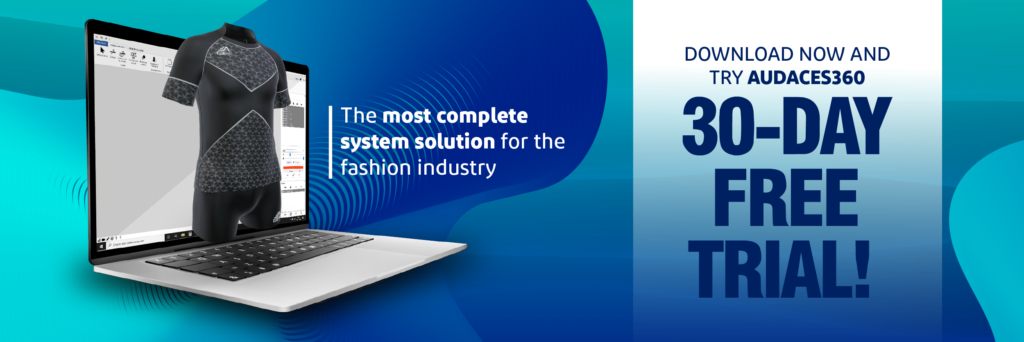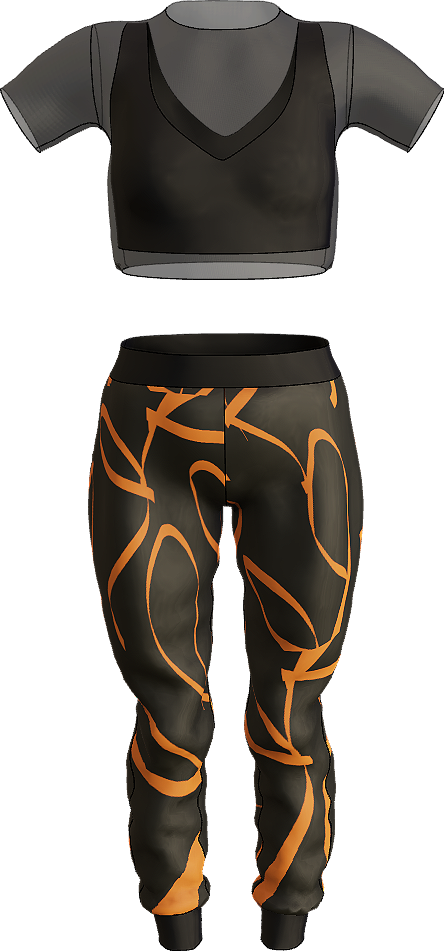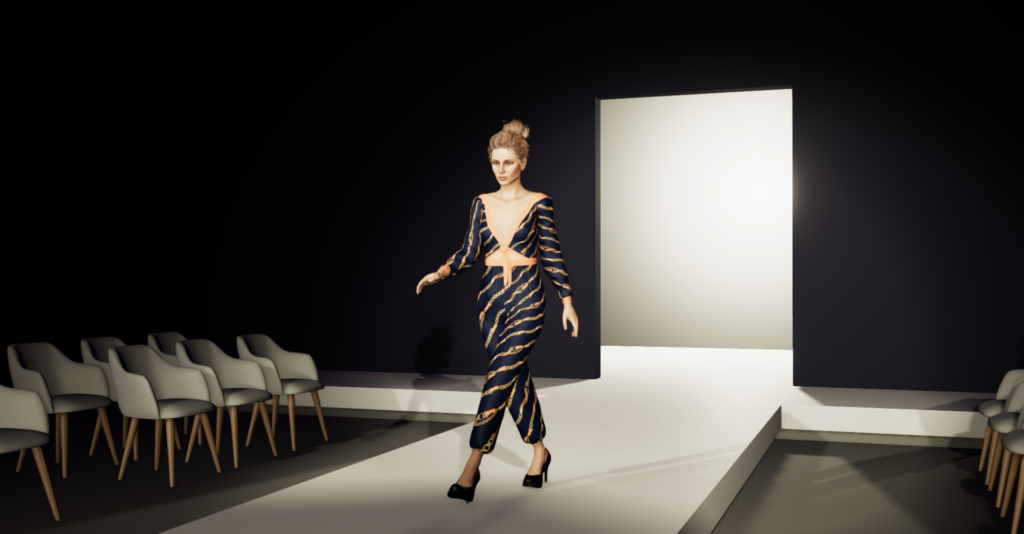Summary:
- The digital fashion market encompasses virtual clothing, digital items utilized as photo filters, game skins, and NFT trading, generating millions of dollars in daily transactions worldwide;
- While virtual clothes were initially created by various graphic designers, including those from the movie and gaming industries, fashion professionals have now established their presence in this domain too;
- Discover how you can leverage your expertise and clothing knowledge in the virtual realm with Audaces360 solutions, which enhance the accuracy of your production. Start your free trial now!

Digital fashion design emerged a long time ago, that’s true. But it was more recently that it started gaining power, even more during the pandemic, when, due to social isolation, online clothing consumption increased significantly.
If digital fashion was more of a thing for the gaming world at the beginning, that art now conquers the catwalks!
There’s still a kind of a dispute in this market between graphic designers and fashion professionals, while some companies already get the importance of combining both talents.
So, catch the drift: whoever starts this career before this trend reaches its peak may guarantee a space when the best moment arrives.
Sumário
In this scenario, learning about the main concepts of this subject is the first step to success.
Happy reading!
What is digital fashion design?

Digital fashion design refers to the entire market for creating and developing clothes within the digital environment.
Therefore, we can talk about skins and accessories for characters in games, digitally created pieces in movies (superheroes clothing, for example), and virtual garments for the common public.
Many people may be wondering what a virtual outfit is for. So, here’s the answer: for plenty of things. That includes consumption and the opportunity to generate revenue for a person or company, but there’s more! We are going to explore this subject further ahead, in the following topics.
Digital fashion design came along with the creation of computer graphics. When people started making images of garments and patterns with data, virtual fashion design was born.
Initially, digital fashion design was more for games and cinema purposes, but its potential for the common customer has been eventually discovered, as we will explain later.
Several brands have already adhered to this concept. Among them are Gucci, Supreme, and Brazilian brand Renner, which have already launched fully computerized fashion collections, that can be used as filters in photos or skins for video game avatars.
The latter was made thanks to collaborations between brands – afterward, the creations turned into physical clothes, just like they are presented in the virtual world. Games become a kind of showcase.
Finally, we can’t fail to mention examples such as the Balenciaga release “Afterworld: The Age of Tomorrow”. In this successful case, a digital fashion game promoted clothing pieces to be sold in their physical versions too.
Learn more: What is Machine Learning and how does it work in Industry 4.0?
How does the digital fashion market work?
The digital fashion market is constantly expanding – in numbers and spaces to occupy. If back in the past, the focus was on games and graphic effects for cinema, today that industry reaches many audiences.
Digital fashion design goes from creating physical clothing pieces to collections made purely from data – which only virtual avatars will wear.
Considering that, it’s hard to delimit how the digital fashion market works. We know where it starts, and you can understand where it is currently, but it’s impossible to predict what tomorrow will be.
Anyways, there are some trends you must study to consider which path seems more attractive for your career or your fashion collection.
We have three striking examples of how digital fashion design behaves today, which serve as a future reference. They are trends and proposals that prove there’s a new range of professionals and types of markets to reach now.
In the past, the fashion industry involved stylists, weavers, tailors, seamstresses, models, and management professionals. Digital fashion design now offers opportunities for digital designers, token investors, system developers, programmers, cybersecurity attorneys, and more.
Check out the hot topics about how digital fashion design works and what the future will look like:
Relationship between digital fashion design and NFT
Non-fungible tokens (NFT) represent a very important market for digital fashion. Brands that launch exclusive pieces can sell their registers and attract fashion enthusiasts, collectors, or investors.
To give you an idea, the NFT market possesses a total market cap of more than $11.3 billion in 2022.
The great advantage of combining NFT trading with fashion is the virtual world’s showcase. Metaverse has an entire market dedicated to the commercialization of this type of digital file. Some brands launched tokens representing physical pieces, not digital-only outfits.
This is another example that digital fashion helps to handle different markets beyond fashion. There is an entire financial and cybersecurity industry behind NFTs.
Learn more: Find out how technology has been applied in the industrial sector
3D digital influencers
What would you think if Lu (Brazilian Magazine Luiza’s virtual assistant) became a supermodel and starred in a campaign to promote a clothing collection?
This is precisely the proposal behind 3D digital influencers: virtual characters that capture the public’s empathy and communicate with niches, becoming examples of behavior, learning, and consumption.
There is a massive investment in creating this type of character. These are usually representations of brands, but they don’t always have to be. What matters is being influential – virtual celebrities who will help sell collections or other products and services for anyone who wants to sponsor.
There is space for several professionals beyond stylists and designers in this market. Animators, speech therapists, musicians, linguists, and others can help create authentic, realistic characters.
Special care must be taken to capture empathy and avoid falling into the Uncanny Valley, a strange sensation that humanoid beings cause in people.
Virtual clothing and game skins
Game skins are visual variations of characters that can change how they move, what they wear, and bring other features.
Virtual clothes are digital files of fashion pieces worn by 3D avatars, real people (that use them like “photo filters”), or game characters.
Videogame character skins can be developed based on digital fashion collections. Similarly, a clothing company can transform a character’s clothing into a virtual or physical outfit. The difference is very tenuous and focuses more on the purpose of use than on the definition of each one.
It is common for fashion brands to use game skins to promote their collections. An example is the collab of League of Legends, a world-famous MOBA-type game, with Louis Vuitton.
The result was characters wearing clothes stylistically in line with the pieces released in the real-life fashion collection.
What are the advantages of entering the digital fashion market?
The digital fashion industry brings numerous innovations and benefits that enhance the market and smart consumption, something that is sought after by audiences around the world.
Fashion planning no longer supports the waste of fabric taken off into the garbage every year. At the same time, new styles and professionals emerge with the democratization of knowledge and creation tools in fashion.
Check out 3 advantages for a clothing company when joining the digital market:
Cost reduction
Do you know how much a clothing company spends annually on raw materials to develop digital fashion collections? Exactly nothing. After all, the pieces are made of data, not using any inch of materials.
For this reason, the virtual fashion market is an exciting field of experimentation. You know those cutouts that people imagine for expensive leather pieces, but they end up giving up, not to waste material? You can do it now in a digital fashion scenario, without worries.
Even if this design is meant for physical production afterward, being able to approve prototypes virtually already reduces a lot of the spending on raw materials.
Sustainability
Did you know that annually, in Brazil, around 170,000 tons of textile waste are discarded within a year of purchase? This is what Bruna Lozano’s research on consumerism and sustainability in fashion shows.
Digital fashion, while being virtual-only, is almost 100% sustainable. The confection only needs to use clean and renewable energy sources to be complete.
In the case of physical clothing brands, doing the creation on the computer and approving it in the file already eliminates all the waste of the development stage.
Inclusion
Digital fashion had the incredible effect of including new professionals from different layers of society in the fashion industry.
It doesn’t matter where you come from, your gender, social class, or nationality.
If you have good taste, are a superb creator, are good at advertising, and have access to technology, you can have your own digital fashion brand.
How to insert your company in the digital fashion market?

Entering the online fashion world depends on a broad knowledge of technology and virtual social behavior. For this purpose, you must define your audience and your objective within the digital market.
Do you intend to make skins for game avatars or digital pieces to use as photo filters? Do you want to work with 3D modeling to be transformed into physical parts, or do you prefer to create virtual clothing for the metaverse?
After figuring it out, you can start developing collections, products, or solutions suitable for your digital or real-life audience.
Besides knowing your public, you must decide whether to work with resellers or final consumers, whether to do it entirely through e-commerce or have kiosk stores, whether to collaborate with brands or whether your products will be 100% independent.
Depending on your niche market, it’s even possible to raise crowdfunding for your ideas or, who knows, get investors by launching a startup. And, of all these lessons, the main one is still: get proficient in technology.
Create your digital fashion collections with Audaces’ support
Audaces is a market leader in the fashion industry and offers a range of digital and physical products for the clothing business.
We help clothing companies to optimize their work, speed up their production, eliminate waste of time and money and make better use of the available workforce.
Our flagship is Audaces360, a complete multi-solution with options such as:
Audaces Isa
Optimize the management of your fashion collections:
- Simplify planning by creating visual maps;
- Define clear steps so that the whole team aims for the same goals;
- Anticipate costs and streamline collections’ approval;
- Track the status of each model in your collection, improving the workflow;
- Create a history of models already developed and reuse them as a basis for planning future collections;
- View reports based on model and collection information.
Audaces Fashion Studio
Create, assemble and showcase looks completely online:
- Develop digital collections without needing patterns;
- Improve creation processes;
- Accelerate and generate instant model approvals;
- Simulate different fits, textures, and materials;
- Test the pieces in hyperrealist avatars;
- Approve 3D fashion designs without having to spend on raw materials or logistics;
- Save time, money, material, and labor.
Audaces 3D
Simulate, sew, and approve clothing pieces in 3D environment:
- Confirm the fit and wearability of the garments;
- Approve the first prototype digitally;
- Save time and costs with prototyping;
- Have a more sustainable process;
- Render images for Marketing and Sales teams;
- Visualize the creations in a virtual fitting room.
Finally, to thank you for reading us this far, we have a gift for you!
Download our free e-book now:
FAQ
Digital fashion design refers to the entire market for creating and developing clothes within the digital environment.
Digital fashion design goes from creating physical clothing pieces to collections made purely from data – which only virtual avatars will wear.
They include cost reduction, sustainability, and inclusion.











2 Responses
This is very comprehensive and well understood.
Thank you!
We’re glad you found our content helpful and easy to understand.
If you have any questions or suggestions, please don’t hesitate to let us know.